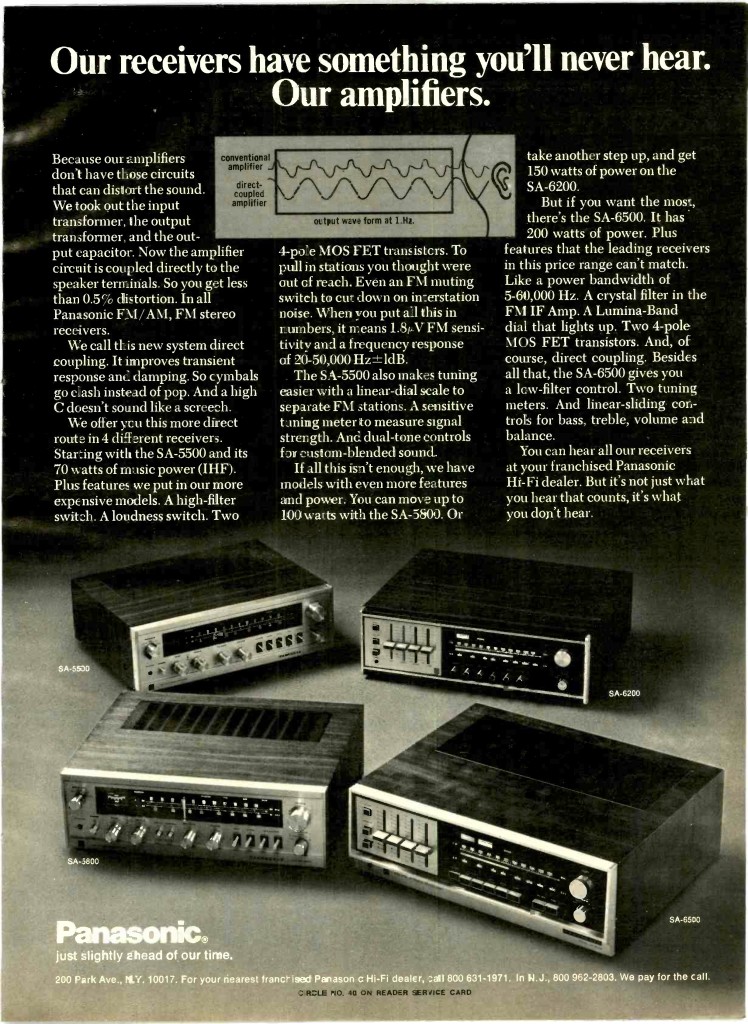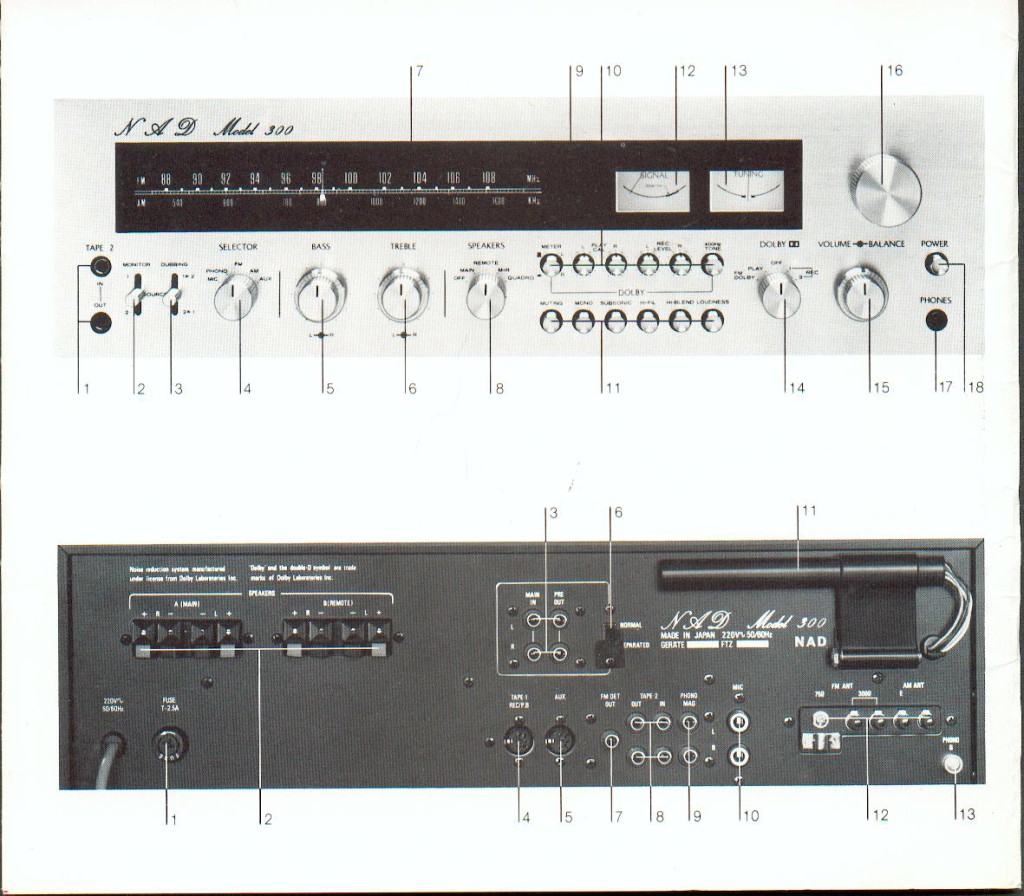 ‘But is it a DC Amplifier?’ he asked. I had been in the middle of boasting about the great sound of one of my vintage amplifiers to an audiophile – who had just spent $80,000 on his brand new Japanese “DC Amplifier”. (yes, I had this actual conversation!)
‘But is it a DC Amplifier?’ he asked. I had been in the middle of boasting about the great sound of one of my vintage amplifiers to an audiophile – who had just spent $80,000 on his brand new Japanese “DC Amplifier”. (yes, I had this actual conversation!)
DC Amplifiers are not a modern phenomenon. Starting in the early 1970s and throughout the Golden Era – the term ‘DC Amplifier’ became an increasingly important selling feature. So important in fact that the actual phrase came to be emblazoned upon many of the components themselves.
DC Amplifiers are also referred to (and are used as) Laboratory Amplifiers because of their ability to accurately reproduce signals from 0Hz and up.
So just what is a DC Amplifier?
Well…the short answer is that it refers to a design that incorporates Direct Current power and something called Direct Coupling as well.
However the long answer is not quite as straight cut as we’d all like. (Buckle up – I am about to get long winded – click here to skip)
This is primarily because the various manufacturers (and their marketing departments) had differing opinions on what the term ‘DC’ actually meant in relation to amplifier design.
For instance Sansui in their 1978 G33000 Brochure clearly stated that their definition of a DC Amplifier was one that employed Direct Coupled architecture. But that was not enough for some, with both Kenwood and Pioneer defining the DC Amplifier as incorporating both Direct Coupled architecture and Direct Current Power.
But it gets even more confusing with discrepancies between manufacturers on the extent that Direct Coupling should be deployed across the amplifier architecture and to even how many components in the amplifier needed to be powered by Direct Current before it could be considered a true DC Amplifier.
Who Invented It?
A brief history…lets start at the beginning, before the term “DC Amplifier” had become a marketing buzz word.
 In this 1972 advertisement (see left) Panasonic made the bold claim to have invented the Direct Coupled Amplifier! They go one step further and claim that they even coined the term “Direct Coupled” as well!!
In this 1972 advertisement (see left) Panasonic made the bold claim to have invented the Direct Coupled Amplifier! They go one step further and claim that they even coined the term “Direct Coupled” as well!!
As to whether this referred to Panasonic’s invention prior to 1971/72 — I don’t know. However, they certainly appear to be the first to advertise in detail Direct Coupled amplifier technology and it’s benefits as far back as 1971.
Specifically Panasonic describe this Direct Coupled architecture as involving the removal of the input and output transformers between stages and also the removal of the coupling capacitors on the amplifier output to the speaker terminals.
Panasonic lists the benefits of this advance as improving transient response and dampening, as well as reducing distortion.
While Panasonic were certainly the first to make a big deal about Direct Coupling in 1971, there are some earlier but brief mentions of direct coupling that predate the Panasonic announcement – at least with a partial Direct Coupled system. For example;
The Acoustech 1 amplifier was advertised with Direct Coupling technology as early as 1962, however it only refers to the removal of the output and driver transformers.
In 1966 Pioneer advertised their SX-1000T 90 Watt Music Power Receiver as having it’s transistors Direct Coupled to the loudspeakers.
And in 1971 the Sansui 8 marketing material refers to it’s preamplifier being Direct Coupled to a Darlington power amplifier, with no output capacitors and it’s dual positive / negative power supplies.
What is certain, from 1973 on-wards all the major audio manufacturers began to introduce their own variations of Direct Coupling into their high-end amplifiers, however it wasn’t until sometime around 1977 that the term ‘DC Amplifier’ really entered the audio lexicon in a big way.

DC Amplifiers are sooo HOT right now!
Now it was Kenwood’s turn to claim to have invented the DC Amplifier – and as such were one of the first to heavily promote the technology in their advertising literature. Specifically it was their 1976-1977 Model 600 (see below) that they claimed to be the worlds first true DC Amplifier. And interestingly, while many of Kenwood’s Amplifiers and Receivers from that catalogue year were described as being ‘Direct Coupled’, only their Model 600 was attributed with the ‘DC Amplifier’ label. What separated the Model 600 from their other Direct Coupled amplifiers? For one it’s frequency response was spec’d out to be from 0Hz – 70,000Hz and it achieved this by the complete removal of all coupling capacitors from the entire audio path – including from the input jacks. All sections and all components of the amplifier were DC powered by two separate power supplies.
So what is a DC Amplifier?
What is Direct Coupling?
 In amplifier design coupling capacitors were utilized between output stages, especially between the power output transistors and the speakers, to prevent DC operating voltages from reaching the speakers. However this is a far from a perfect solution – it’s expensive to implement properly, the capacitors leak the DC voltage through when reproducing low-frequencies and they also introduced phase-shift distortion. Initially, amplifiers that had eliminated these coupling capacitors in the power output stage were often described as being Direct Coupled.
In amplifier design coupling capacitors were utilized between output stages, especially between the power output transistors and the speakers, to prevent DC operating voltages from reaching the speakers. However this is a far from a perfect solution – it’s expensive to implement properly, the capacitors leak the DC voltage through when reproducing low-frequencies and they also introduced phase-shift distortion. Initially, amplifiers that had eliminated these coupling capacitors in the power output stage were often described as being Direct Coupled.
AC or DC Powered?

Sources of distortion: Conceptual diagram showing transformers and capacitors between amplifier stages.
AC power amplifiers also contained power transformers between stages, so amplifiers that were DC powered throughout the signal path meant that these input and output transformers between stages could be done away with, saving the signal from further distortions.
In the race for audio excellence of the 1970s some high-end amplifiers came to eliminate all coupling capacitors completely from the audio signal path, from the inputs to preamplification, equalization sections and to the eventual power output stages. The goal was to ensure that the amplified output signal would be harmonically identical to the input signal – a trait often referred to as zero coloration. Many of these amplifiers were marketed as being DC Amplifiers.
However some companies described the practice of removing all coupling capacitors as dangerous and insisted that coupling capacitors needed to be retained on the inputs.
The Benefits of DC Amplifiers.
In general terms the potential benefits of DC Amplifier technology included improved frequency response (from 0Hz and up) offering a broader spectrum frequency range from the ultra-low to the ultra-high, low distortion (particularly with low-frequencies), tremendous bass response and higher dampening factors, improved signal to noise ratio, no phase distortion, and lower output distortion. Human translation: Great bass response and crisp accurate musical reproduction throughout a broad spectrum.
And the Bad?
One criticism is that DC Amplifiers draw power to reproduce signals that are inaudible, taking away from the power available to reproduce the audible sounds. To counter this many DC Amplifiers were fitted with a Sub-Sonic filters to prevent these signals from entering the audio path.
Incidentally its possible for these inaudible frequencies to destroy your speakers, as I have learned first hand with a Sansui R-70 whose Servo Circuit was no longer working correctly. Remember some of the early DC amps had virtually no protection against this so make sure you turn the amplifier off before connecting and disconnecting inputs!
There are a couple of things to check for when looking at a DC amplifier. The first is that they need to be well maintained, specially in relation to +/- rail voltages, referred to as DC offset. Left and Right speaker outputs should measure as close to 0v as possible with the volume set to 0, as measured by a multi-meter. If the DC offset is too far out, your ears will suffer.
Some techies claim that DC amplifiers are difficult to fault find, however the old school audio technicians that I know have no problem diagnosing issues in them.
But are they better?
YES! – DC Amplifiers perform and sound better than AC Amplifiers hands down! It was a major technological advancement and marked a drastic improvement over the previous solid state amplifiers.
As audio technology progressed in the 1970s virtually all mainline amplifiers came to feature some level of DC tech in their architecture to varying extents. Some carried the DC Label and many did not even though they employed DC power and Direct Coupled architecture. (As seen within the Kenwood range).
However thanks to the marketing jargon comparing one DC amplifier from Brand ‘A’ to another one from Brand ‘B’ is where it becomes challenging.
So yes, broadly speaking on a diagnostic lab bench a DC Amplifier will outperform other ‘non-DC’ amplifiers. There are many other technical and qualitative factors that go into producing a truly great amplifier and ultimately the appreciation of sound will always remain a human qualitative aesthetic.
Look at the Specs and Listen to your Ears!
So with that in mind lets take a look at some of the prime examples of DC Amplifiers created during the Golden Age…
Introducing the DC Amplifier’s…
While many variations on DC technology had been quietly introduced by many brands from sometime in the early to mid Seventies, it wasn’t until 1978 that the marketing departments really began to push it as a key selling feature.
Kenwood’s Model 600
The first “True” DC Amplifier (according to Kenwood)
No coupling capacitors anywhere in sight and powered by pure DC, each channel completely independently powered for maximum separation and dynamic response. Kenwood also went one further and created a new metric they called Dynamic Dampening Factor – a measurement of adverse effect from speaker generated counter-electromotive force.
Incidentally, Kenwood was one of the brands that had eliminated the coupling capacitors from the inputs in their range of DC Amplifiers.

From Kenwood’s 1978 KA-8100 Brochure demonstrating the superiority of DC powered amplifiers over AC powered amplifiers.
Pioneer SX-1980 – “The Greatest DC Story Ever Told…”

Pioneer’s Monster 1978 receiver, the SX-1980, was also heavily promoted for its ‘DC with a Difference’ technology. Pioneer claimed that this technology retained the coupling capacitors on the INPUT stage of the amplifier to protect speakers from ‘DC-caused break down’ – a condition where speakers exposed to true DC signals suffer ‘immediate and severe damage’. Pioneer promoted this receiver as being ‘The Greatest DC Story Ever Told’.
Sansui G-33000
Sansui’s top models G-22000 and G-33000 released in 1978 were also promoted for their DC architecture, specifically Sansui’s version of it they called “Straight DC” and “Diamond Differential DC”. Sansui were one of the company’s that insisted on removing the coupling capacitors on the signal inputs.
By 1980 Sansui had deployed this technology in various forms across their entire range of Receivers and even created a new range of Receiver/Amplifiers the ‘R’ Series – featuring Sansui’s “DC Servo” technology designed to protect speakers from damage.















 1
1 2
2 3
3 4
4 5
5 6
6 7
7 8
8

 An historic piece this unit was positioned at the pinnacle of NAD’s very first product line. Developed by Bjorn Erik Edvardsen under the founder Dr. Martin L. Borish the Model 300 was manufactured by Foster
An historic piece this unit was positioned at the pinnacle of NAD’s very first product line. Developed by Bjorn Erik Edvardsen under the founder Dr. Martin L. Borish the Model 300 was manufactured by Foster The next thing that hits you is the size of the power supply. The transformer is generously sized and is accompanied by two large 18,000uf filter capacitors. For instance the 1978 Marantz Model 2600 boasting 300 Watts RMS per channel output was being powered with less capacitance than the Model 300! I guess this is what NAD is talking about when they say “effective power”. It’s great to see a company taking their mission statement seriously! The sound is rich, abundant and detailed with a velvet feel backed by effortless power, it the rare kind of sound that you can ‘hear’ with your heart. One of my audiophile friends could not hide his disbelief at hearing this unit perform, his jaw dropped and his mouth remained open for quite some time!!
The next thing that hits you is the size of the power supply. The transformer is generously sized and is accompanied by two large 18,000uf filter capacitors. For instance the 1978 Marantz Model 2600 boasting 300 Watts RMS per channel output was being powered with less capacitance than the Model 300! I guess this is what NAD is talking about when they say “effective power”. It’s great to see a company taking their mission statement seriously! The sound is rich, abundant and detailed with a velvet feel backed by effortless power, it the rare kind of sound that you can ‘hear’ with your heart. One of my audiophile friends could not hide his disbelief at hearing this unit perform, his jaw dropped and his mouth remained open for quite some time!!